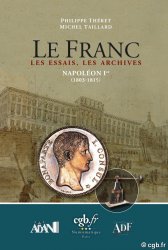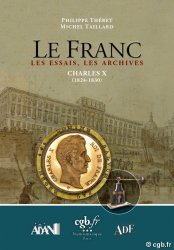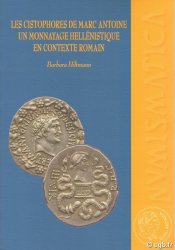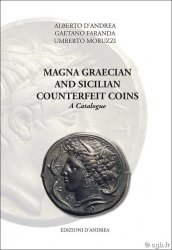lf32 - Le Franc Les Essais, Les Archives - Louis-Philippe (1830-1848) - A paraître THÉRET Philippe, TAILLARD Michel
59.00 €(Approx. 69.03$ | 51.33£)
Quantity
Add to your cart

Author : THÉRET Philippe, TAILLARD Michel
Publisher : Les Chevau-légers - CGF
Language : Français
Description : Paris 2025, broché, (16,5 x 24 cm), 800 pages, illustrations en couleur, cotes en Euro pour 4 ou 5 états de conservation
Weight : 1600 g.
Commentary
Following Le Franc les Monnaies, les Archives (2019) and Le Franc d’Augustin Dupré (2021), discover Le Franc, les Essais, les Archives, a six-volume encyclopaedia (2023–2027) that enriches and completes our knowledge of the history of the Franc between 1803 and 1870. This fourth volume, devoted to Louis-Philippe (1830-1848), is being published on the 175th anniversary of the death of the King of the French (26 August 1850). It joins the first three books, dedicated to Napoleon I (1803-1815), Louis XVIII (1814-1824) and Charles X (1824-1830).
With 800 pages, this work is currently the most voluminous in the series and marks an important milestone in the history of the franc and France. Indeed, at the dawn of the second half of the 19th century, the country embarked on its first industrial revolution, which was reflected in technical improvements in coin production. In line with previous works, the use of ‘paper’ and ‘metal’ archives immerses the reader in the monetary history of Louis-Philippe's reign. Objective information, a precise and meticulous catalogue, market-reflective ratings, high-definition iconography, accompanied by a gallery where coins and tools rub shoulders, are the major assets of this work, which is a must-read!
Philippe Théret and Michel Taillard, supported by the associations ADF (Amis du Franc) and ADAN (Amis des Auteurs Numismates), have set out to provide collectors and professionals with new tools for exploring the fascinating field of trial coins from the period 1803 to 1870. That is to say, from the creation of the Franc Germinal under Napoleon Bonaparte to the fall of Napoleon III.
The scope of the trials is broad: competition trials, type trials, technical trials, engraver's creation proofs, die test proofs before being sent to the workshops, political propaganda trials (Napoleon II, Henri V, ...), prestige strikes for dignitaries, burnished blanks, apocryphal strikes for collectors, visiting coins at the Mint (in Paris or the provinces), etc.
A six-volume collection (one per period) has been in preparation since mid-2021.
The largest public institutions have collaborated in the production of these works:
- The Paris Mint opened the doors of its medal collections (4,500 photos taken) as well as those of the red zone of the Pessac factory where the Museum's monetary tools are kept (12,000 photos taken); this period of the 19th century (5,000 photos taken);
- The Bibliothèque nationale de France enabled the prestigious collections from this period of the 19th century to be studied and photographed (5,000 photographs taken);
- The Carnavalet Museum and its invaluable numismatic collection (2,500 photos taken);
- The Medal Cabinet of the Royal Library of Belgium, the Banque de France, etc.
It is clear that public collections have contributed greatly to the inventory for the various publications. However, it would be reductive to consider only these sources. These collections, admirable as they are, do not contain all the different essays. The catalogues of various sales over time have not only made it possible to refine this inventory, but also to assess the frequency of appearance, rarity, prices and their evolution.
In addition to these crucial contributions, 160,000 pages of archives, digitised over the last 20 years, have been exploited. This has made it possible to give meaning to most of the essays and, in a number of cases, to provide manufacturing figures!
In this collection of books, the structure of each work remains the same: a first part dedicated to the archives, a second part devoted to the census catalogue (with references) and finally a third part with a full-page photo gallery.
The ‘Gallery’ section was created for your viewing pleasure! It allows you to see exceptional trials (in terms of rarity or condition) in enlarged format (made possible by the 24x16 format of the books). Some monetary tools are also presented there. Collectors of circulating coins who are less interested in proofs will also find something to enjoy in the plates dedicated to circulating coins in burnished blanks. This will be an opportunity to appreciate the engraving details of our circulating coins, which few collectors have had the chance to see!.
Following Le Franc les Monnaies, les Archives (2019) and Le Franc d'Augustin Dupré (2021), discover Le Franc, les Essais, les Archives, a six-volume encyclopaedia (2023–2027) that enriches and completes our knowledge of the history of the Franc between 1803 and 1870. This fourth volume, devoted to Louis-Philippe (1830-1848), is being published on the 175th anniversary of the death of the King of the French (26 August 1850). It joins the first three books, dedicated to Napoleon I (1803-1815), Louis XVIII (1814-1824) and Charles X (1824-1830).
With 800 pages, this work is currently the most voluminous in the series and marks an important milestone in the history of the franc and France. Indeed, at the dawn of the second half of the 19th century, the country embarked on its first industrial revolution, which was reflected in technical improvements in coin production. In line with previous works, the use of 'paper' and 'metal' archives immerses the reader in the monetary history of Louis-Philippe's reign. Objective information, a precise and meticulous catalog, market-reflective ratings, high-definition iconography, accompanied by a gallery where coins and tools rub shoulders, are the major assets of this work, which is a must-read! Philippe Théret and Michel Taillard, supported by the associations ADF (Amis du Franc) and ADAN (Amis des Auteurs Numismates), have set out to provide collectors and professionals with new tools for exploring the fascinating field of trial coins from the period 1803 to 1870. That is to say, from the creation of the Franc Germinal under Napoleon Bonaparte to the fall of Napoleon III.
The scope of the trials is broad: competition trials, type trials, technical trials, engraver's creation proofs, die test proofs before being sent to the workshops, political propaganda trials (Napoleon II, Henri V, . . . ), prestige strikes for dignitaries, burned blanks, apocryphal strikes for collectors, visiting coins at the Mint (in Paris or the provinces), etc..
A six-volume collection (one per period) has been in preparation since mid-2021.
The largest public institutions have collaborated in the production of these works: - The Paris Mint opened the doors of its medal collections (4,500 photos taken) as well as those of the red zone of the Pessac factory where the Museum's monetary tools are kept (12,000 photos taken); this period of the 19th century (5,000 photos taken); - The Bibliothèque nationale de France enabled the prestigious collections from this period of the 19th century to be studied and photographed (5,000 photographs taken); - The Carnavalet Museum and its invaluable numismatic collection (2,500 photos taken); - The Medal Cabinet of the Royal Library of Belgium, the Banque de France, etc..
It is clear that public collections have contributed greatly to the inventory for the various publications. However, it would be reductive to consider only these sources. These collections, admirable as they are, do not contain all the different essays. The catalogs of various sales over time have not only made it possible to refine this inventory, but also to assess the frequency of appearance, rarity, prices and their evolution.
In addition to these crucial contributions, 160,000 pages of archives, digitized over the last 20 years, have been exploited. This has made it possible to give meaning to most of the essays and, in a number of cases, to provide manufacturing figures! In this collection of books, the structure of each work remains the same: a first part dedicated to the archives, a second part devoted to the census catalog (with references) and finally a third part with a full-page photo gallery.
The 'Gallery' section was created for your viewing pleasure! It allows you to see exceptional trials (in terms of rarity or condition) in enlarged format (made possible by the 24x16 format of the books). Some monetary tools are also presented there. Collectors of circulating coins who are less interested in proofs will also find something to enjoy in the plates dedicated to circulating coins in burned blanks. This will be an opportunity to appreciate the engraving details of our circulating coins, which few collectors have had the chance to see!
With 800 pages, this work is currently the most voluminous in the series and marks an important milestone in the history of the franc and France. Indeed, at the dawn of the second half of the 19th century, the country embarked on its first industrial revolution, which was reflected in technical improvements in coin production. In line with previous works, the use of ‘paper’ and ‘metal’ archives immerses the reader in the monetary history of Louis-Philippe's reign. Objective information, a precise and meticulous catalogue, market-reflective ratings, high-definition iconography, accompanied by a gallery where coins and tools rub shoulders, are the major assets of this work, which is a must-read!
Philippe Théret and Michel Taillard, supported by the associations ADF (Amis du Franc) and ADAN (Amis des Auteurs Numismates), have set out to provide collectors and professionals with new tools for exploring the fascinating field of trial coins from the period 1803 to 1870. That is to say, from the creation of the Franc Germinal under Napoleon Bonaparte to the fall of Napoleon III.
The scope of the trials is broad: competition trials, type trials, technical trials, engraver's creation proofs, die test proofs before being sent to the workshops, political propaganda trials (Napoleon II, Henri V, ...), prestige strikes for dignitaries, burnished blanks, apocryphal strikes for collectors, visiting coins at the Mint (in Paris or the provinces), etc.
A six-volume collection (one per period) has been in preparation since mid-2021.
The largest public institutions have collaborated in the production of these works:
- The Paris Mint opened the doors of its medal collections (4,500 photos taken) as well as those of the red zone of the Pessac factory where the Museum's monetary tools are kept (12,000 photos taken); this period of the 19th century (5,000 photos taken);
- The Bibliothèque nationale de France enabled the prestigious collections from this period of the 19th century to be studied and photographed (5,000 photographs taken);
- The Carnavalet Museum and its invaluable numismatic collection (2,500 photos taken);
- The Medal Cabinet of the Royal Library of Belgium, the Banque de France, etc.
It is clear that public collections have contributed greatly to the inventory for the various publications. However, it would be reductive to consider only these sources. These collections, admirable as they are, do not contain all the different essays. The catalogues of various sales over time have not only made it possible to refine this inventory, but also to assess the frequency of appearance, rarity, prices and their evolution.
In addition to these crucial contributions, 160,000 pages of archives, digitised over the last 20 years, have been exploited. This has made it possible to give meaning to most of the essays and, in a number of cases, to provide manufacturing figures!
In this collection of books, the structure of each work remains the same: a first part dedicated to the archives, a second part devoted to the census catalogue (with references) and finally a third part with a full-page photo gallery.
The ‘Gallery’ section was created for your viewing pleasure! It allows you to see exceptional trials (in terms of rarity or condition) in enlarged format (made possible by the 24x16 format of the books). Some monetary tools are also presented there. Collectors of circulating coins who are less interested in proofs will also find something to enjoy in the plates dedicated to circulating coins in burnished blanks. This will be an opportunity to appreciate the engraving details of our circulating coins, which few collectors have had the chance to see!.
Following Le Franc les Monnaies, les Archives (2019) and Le Franc d'Augustin Dupré (2021), discover Le Franc, les Essais, les Archives, a six-volume encyclopaedia (2023–2027) that enriches and completes our knowledge of the history of the Franc between 1803 and 1870. This fourth volume, devoted to Louis-Philippe (1830-1848), is being published on the 175th anniversary of the death of the King of the French (26 August 1850). It joins the first three books, dedicated to Napoleon I (1803-1815), Louis XVIII (1814-1824) and Charles X (1824-1830).
With 800 pages, this work is currently the most voluminous in the series and marks an important milestone in the history of the franc and France. Indeed, at the dawn of the second half of the 19th century, the country embarked on its first industrial revolution, which was reflected in technical improvements in coin production. In line with previous works, the use of 'paper' and 'metal' archives immerses the reader in the monetary history of Louis-Philippe's reign. Objective information, a precise and meticulous catalog, market-reflective ratings, high-definition iconography, accompanied by a gallery where coins and tools rub shoulders, are the major assets of this work, which is a must-read! Philippe Théret and Michel Taillard, supported by the associations ADF (Amis du Franc) and ADAN (Amis des Auteurs Numismates), have set out to provide collectors and professionals with new tools for exploring the fascinating field of trial coins from the period 1803 to 1870. That is to say, from the creation of the Franc Germinal under Napoleon Bonaparte to the fall of Napoleon III.
The scope of the trials is broad: competition trials, type trials, technical trials, engraver's creation proofs, die test proofs before being sent to the workshops, political propaganda trials (Napoleon II, Henri V, . . . ), prestige strikes for dignitaries, burned blanks, apocryphal strikes for collectors, visiting coins at the Mint (in Paris or the provinces), etc..
A six-volume collection (one per period) has been in preparation since mid-2021.
The largest public institutions have collaborated in the production of these works: - The Paris Mint opened the doors of its medal collections (4,500 photos taken) as well as those of the red zone of the Pessac factory where the Museum's monetary tools are kept (12,000 photos taken); this period of the 19th century (5,000 photos taken); - The Bibliothèque nationale de France enabled the prestigious collections from this period of the 19th century to be studied and photographed (5,000 photographs taken); - The Carnavalet Museum and its invaluable numismatic collection (2,500 photos taken); - The Medal Cabinet of the Royal Library of Belgium, the Banque de France, etc..
It is clear that public collections have contributed greatly to the inventory for the various publications. However, it would be reductive to consider only these sources. These collections, admirable as they are, do not contain all the different essays. The catalogs of various sales over time have not only made it possible to refine this inventory, but also to assess the frequency of appearance, rarity, prices and their evolution.
In addition to these crucial contributions, 160,000 pages of archives, digitized over the last 20 years, have been exploited. This has made it possible to give meaning to most of the essays and, in a number of cases, to provide manufacturing figures! In this collection of books, the structure of each work remains the same: a first part dedicated to the archives, a second part devoted to the census catalog (with references) and finally a third part with a full-page photo gallery.
The 'Gallery' section was created for your viewing pleasure! It allows you to see exceptional trials (in terms of rarity or condition) in enlarged format (made possible by the 24x16 format of the books). Some monetary tools are also presented there. Collectors of circulating coins who are less interested in proofs will also find something to enjoy in the plates dedicated to circulating coins in burned blanks. This will be an opportunity to appreciate the engraving details of our circulating coins, which few collectors have had the chance to see!








 Click here to browse the flip book
Click here to browse the flip book Report a mistake
Report a mistake Print the page
Print the page Share my selection
Share my selection Ask a question
Ask a question
 Full data
Full data








